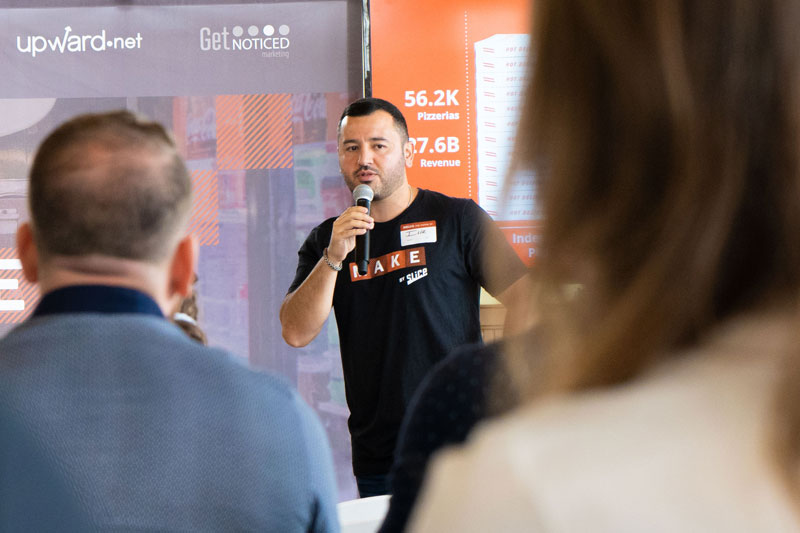With the fresh idea of creating a delivery marketplace exclusively for independent pizzerias, Slice has attracted more than $80 million from investors who see the massive potential of helping small pizza restaurants compete with the Domino’s and Papa John’s of the world in technology, bulk pricing and marketing.
Slice, after recently surpassing more than a billion dollars in transactions on the platform from 14,000 partnered restaurants, is stepping on the gas to go further than just aggregating customer demand. With a unique model that Slice’s co-founder and CEO Ilir Sela calls “reverse franchising,” the company is banding independent pizzerias together for collective bargaining power on everything from delivery commissions to napkins and pizza boxes.
“Whether you’re a big brand like Pizza Hut or a small business with one location, not having a digital strategy doesn’t forgive anyone,” Sela said. “If you don’t have that going for yourself, really investing in that world, you’re gonna lose—and you’re seeing Pizza Hut struggle as a result of years and years of falling behind around that platform and infrastructure.”
After years of massive investments in consumer-facing delivery technology, the largest pizza chains have bucked the nearly across-the-board negative sales trends in the North American restaurant space in 2020. While it would be impossible for any independent restaurant operator to develop its own live order tracking software, for example, Slice believes that the power of numbers can give small pizzerias the ability to compete on a level footing with no excuses.
On paper, the size of the opportunity is huge as Slice estimates more than two-thirds of the U.S. pizza market are small businesses, compared to the franchised giants in the space. Bringing those independents sophisticated online ordering; a modern digital presence on Google, Facebook and Instagram; customer relationship marketing; loyalty; upselling; and detailed data analytics are the pillars of Slice’s offering.
“Not having a digital strategy doesn’t forgive anyone. If you don’t have that going for yourself, really investing in that world, you’re going to lose,” Sela added. “If a small business pizzeria joins Slice today, they get millions of dollars of technology, which I would argue is better than the Domino’s platform available to them with the flip of a switch.”
Restaurants on Slice are responsible for conducting their own deliveries, since the company doesn’t employ its own delivery drivers.
In an environment where owning a small restaurant business drifts farther away from being a good chef or manager, outsourcing now-critical functions allows owner-operators to focus on what they’re truly passionate about, the company’s CEO says, rather than negotiating delivery contracts or the next paper goods order.
If that wasn’t enough nitty-gritty to bite off, Slice has launched its new Accelerate program to go even further, giving select restaurants what it calls a $15,000 package of technology and services to help make them “pandemic-proof and set up for future success.”
The goal is fully modernizing independent operations with one to three locations to boost efficiency, add consistent brand messaging, upgrade and enhance websites, optimize search profiles to reach new customers, in-depth evaluations of menu pricing and, in general, rethinking everything from logos to customized packaging. Restaurants can be nominated to take part in the program and Slice will evaluate each nomination to select the next round of pizzerias it will include in its Accelerate program.
Sela estimates that $29 billion of the $47-billion U.S. pizza industry is enough potential to keep the company’s workforce of approximately 700 busy in the near future. According to its internal data, 60 percent of big pizza chain orders are digital, whereas that figure is only 5 percent among smaller independents.
By aggregating delivery fee negotiation with its entire network, Sela says the company can approach third-party delivery brands like Grubhub and say “look, we’re happy to work with you and list these locations [on your platform], but you’ve got to give us a favorable deal.” He added that conversations are ongoing with delivery providers, which is critical for operators trying to profit with what he calls “drive-by aggregators.”
Slice charges its merchant restaurants a flat fee on a per order basis, $2.25 per order with a pass-through fee for credit-card processing. Sela stressed that all of its services are covered under that $2.25 fee, which has been enough to move the company back into profitability in recent months, fueled by the fast growth of new restaurants on the platform.
Slice doesn’t take any ownership in brands on its platform or taking part in the Accelerate program. Moving so much further beyond listing restaurants on its marketplace is a first in the on-demand space, and close to a franchise model without actually taking a legal stake in the restaurants it works with.
“It’s been an uphill battle to articulate exactly what we’re trying to accomplish,” Sela said. “I personally believe that local entrepreneurs should not have to sacrifice their creative freedom in order to get the same benefits that a franchise model offers.”




